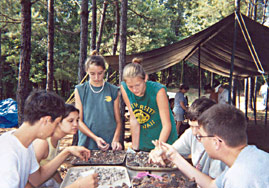
TUSCALOOSA, Ala. – Experts with The University of Alabama’s Alabama Museum of Natural History will lead a team of youth and adult explorers to excavate the remains of Fort Toulouse in Wetumpka, in four sessions, June 6-30.
The group will help scientists dig up new details about the 18th-century French fort, at an intersection of trade routes where troops mutinied, treaties were signed, and great nations held each other at bay.
“Our camp will be situated near the Coosa and Tallapoosa river junction where a lot of fascinating events in Alabama history took place,” said Randy Mecredy, assistant director and education outreach coordinator for the Museum, who will lead the program.
Fort Toulouse/Fort Jackson Park is located at 2521 West Ft. Toulouse Road and is this year’s site for the 26th annual Museum Expedition.
Archaeologists maintain that the area was first inhabited around 5000 B.C. by a band of nomadic hunters. Since then, Indian mound builders, Spanish explorers, French soldiers, English and Scottish traders, and American settlers have left their marks on the site.
“We’ll learn more about Louis de Lantagnac,” said Mecredy. “As a 13-year-old ensign stationed at Fort Toulouse, young Louis was taken prisoner by a band of Chickasaw Indians and traded to the English in Charleston for goods and ammunition.”
According to Mecredy, Lantagnac spent the next three years gaining the confidence of the English governor, who outfitted him to trade with the Cherokees. He traded among the Indians for six years and had a son by a Cherokee woman with whom he lived at Great Tellico. He later returned to Fort Toulouse, his absence was pardoned, his rank was restored, and he served as an interpreter for the post commandant.
“Lantagnac was so successful at promoting a pro-French faction among the Cherokees that the English offered a bounty for his scalp,” said Mecredy. “His account is one of many interesting stories about the history and life of the French soldiers and inhabitants of Fort Toulouse.”
A small garrison of French Marines built Fort Toulouse in 1717, by request from the Alibamu Indians, to protect the region from the British and to establish trade with the Native Americans.
By the late 1740s the French rebuilt the dilapidated original fort, but lost it to the British in 1763. Creek Indians lived in the area until 1814 when Andrew Jackson built Fort Jackson on the same site, but by the end of 1819, residents had moved down river to what later became Montgomery. The remains of the site of the three forts had become farmland, and in 1971 The Alabama Historical Commission acquired the property.
“Only a small percentage of the site has been excavated by professionally trained archaeologists,” said Mecredy. “This will be our first expedition to Ft. Toulouse/Ft. Jackson, and we hope to gather new data and help provide additional information about the first French fort located there,” he said. “Previous years’ dig participants have assembled dozens of artifacts, from coins to smoking pipes to utensils and glassware to musket balls, and more than 50 restorable ceramic vessels.”
The UA Museum began this annual field science program with professional and academic archaeologists in 1979. Originally designed exclusively for high school students, teachers, and parents, the Museum Expedition now accepts any history, science, or archaeology enthusiast who wishes to learn excavation techniques, lab procedures, and artifact identification. The program remains one of only a few in the country to provide a hands-on science field experience to participants as young as age 14.
The Museum Expedition offers high school students an opportunity to develop projects for science and social studies fairs, and, with advance arrangements, students may also receive elective high school credit. Teachers who participate can earn University of Alabama continuing education units or professional development hours, and college students can earn UA course credit.
Accommodations, food and scientific equipment are provided. This cost is $400 per full week per person; $200 for the last condensed session, June 27-30. Qualifying students may apply for a scholarship. An overnight program is available, June 15-16, at a cost of $65. Discounts are available for UA Museum Members.
To register, phone 205/348-7550, e-mail museum.expedition@ua.edu, or visit the web site at http://www.museums.ua.edu/history/archcamp.html.
EDITOR’S NOTE: A media availability is scheduled for June 17 at 10 a.m. at Ft. Toulouse/Jackson Park for reporters and community leaders to get a behind-the-scenes guided tour of the excavation.
Contact
Kristi Wheeler-Griffin, Marketing & Public Relations, UA Museums, 205/348-2041Chris Bryant, 205/348-8323
Source
Randy Mecredy, 205/348-2136